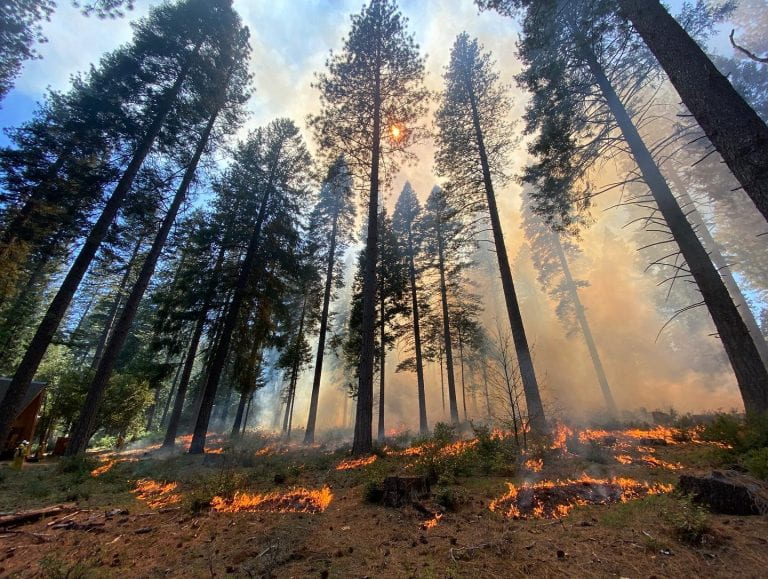IRVINE, California
,
June 7, 2022
(press release)
–
UCI scientists make the discovery using improved tracking algorithms An interdisciplinary team of researchers at the University of California, Irvine, recently spent time at the University of California’s Blodgett Forest Research Station in the Sierra Nevada mountain range. The researchers conducted field studies of the impact of wildfires on California’s alpine ecosystems. Audrey Odwuor / UCI Human-caused wildfires in California are more ferocious than blazes sparked by lightning, a team led by scientists from the University of California, Irvine reported recently in the journal Nature Communications. The research could help scientists better understand fire severity and how likely a blaze is to kill trees and inflict long-term damage on an ecosystem in its path. California is no stranger to wildfires; in 2020 alone, over 4 million acres burned across the state, including the million-acre August Complex Fire. But what’s been unclear until now was whether there was any difference in severity between wildfires that start naturally, from lightning strikes, versus those touched off by humans. “Human-ignited fires grow more rapidly and release more energy as they’re growing because they’re often sparked under conditions that are hotter and drier,” said James Randerson, Ralph J. and Carol M. Cicerone Professor of Earth system science at UCI and co-author of the study. “They’re more ferocious.” In contrast, lightning-strike blazes typically occur in weather with somewhat higher humidity, which can limit flame intensity. The work was made possible by UCI advances in fire modeling that enable scientists to better understand the forces that govern how fast blazes move. Those advances were detailed in a separate new study published in Scientific Data. “We created a fire tracking algorithm and applied it to the past nine fire seasons in California, which helped analyze the location, energy and spread of different types of fires,” said Yang Chen, an assistant researcher in the Department of Earth System Science. To build their algorithm, Chen and colleagues looked at thermal hotspots from fire activity with an imaging device on the National Oceanic and Atmospheric Administration’s Suomi satellite. This allows for near-real-time tracking and modeling of wildfires. “These types of data have been available in the past for individual fires,” said Randerson. “But it hasn’t been organized systematically, and it hasn’t been available across all the fires in a region. That’s where this new product helps. It allows us to identify where in California the fires burn fastest and how that relates to the weather and vegetation at a particular spot.” This two-study effort was also one of the first times scientists have been able to link a fire’s speed and energy release to its long-term effects on ecosystems — which can last for decades or even centuries. “The importance of this algorithm is that it could allow us to build better fire models in California and better track wildfires in parts of the world where we don’t have aircraft and multiple satellite sensors measuring fires around the clock,” Randerson added. “So this may be valuable for understanding fire behavior in remote boreal forests and in the understory of tropical forests.” Both new studies have special relevance for California, where increasing fire severity is leading to more and more property damage, civilian and firefighter fatalities, ecosystem degradation and poor air quality. Co-author Douglas Morton and visualization engineer Cynthia Starr from NASA’s Goddard Space Flight Center created animations of these new data for the Caldor fire and the Dixie fire. These two fires had devastating impacts on several California communities in the Sierra Nevada mountains during the 2021 wildfire season. The data visualizations for these fires illustrate how quickly fire behavior can change from day-to-day variations in weather and the fires burning into new areas with different levels of fuel accumulation. The two studies included contributions from researchers at NASA’s Goddard Space Flight Center, Universidad del Rosario in Bogotá, Colombia, and Cardiff University in the United Kingdom. The research was funded by NASA, California’s Strategic Growth Council, and the University of California’s National Laboratory Fees grant program. About UCI’s Brilliant Future campaign: Publicly launched on Oct. 4, 2019, the Brilliant Future campaign aims to raise awareness and support for UCI. By engaging 75,000 alumni and garnering $2 billion in philanthropic investment, UCI seeks to reach new heights of excellence in student success, health and wellness, research and more. The School of Physical Sciences plays a vital role in the success of the campaign. Learn more by visiting https://brilliantfuture.uci.edu/uci-school-of-physical-sciences/. About the University of California, Irvine: Founded in 1965, UCI is the youngest member of the prestigious Association of American Universities and is ranked among the nation’s top 10 public universities by U.S. News & World Report. The campus has produced five Nobel laureates and is known for its academic achievement, premier research, innovation and anteater mascot. Led by Chancellor Howard Gillman, UCI has more than 36,000 students and offers 224 degree programs. It’s located in one of the world’s safest and most economically vibrant communities and is Orange County’s second-largest employer, contributing $7 billion annually to the local economy and $8 billion statewide. For more on UCI, visit www.uci.edu. 
* All content is copyrighted by Industry Intelligence, or the original respective author or source. You may not recirculate, redistrubte or publish the analysis and presentation included in the service without Industry Intelligence's prior written consent. Please review our terms of use.




